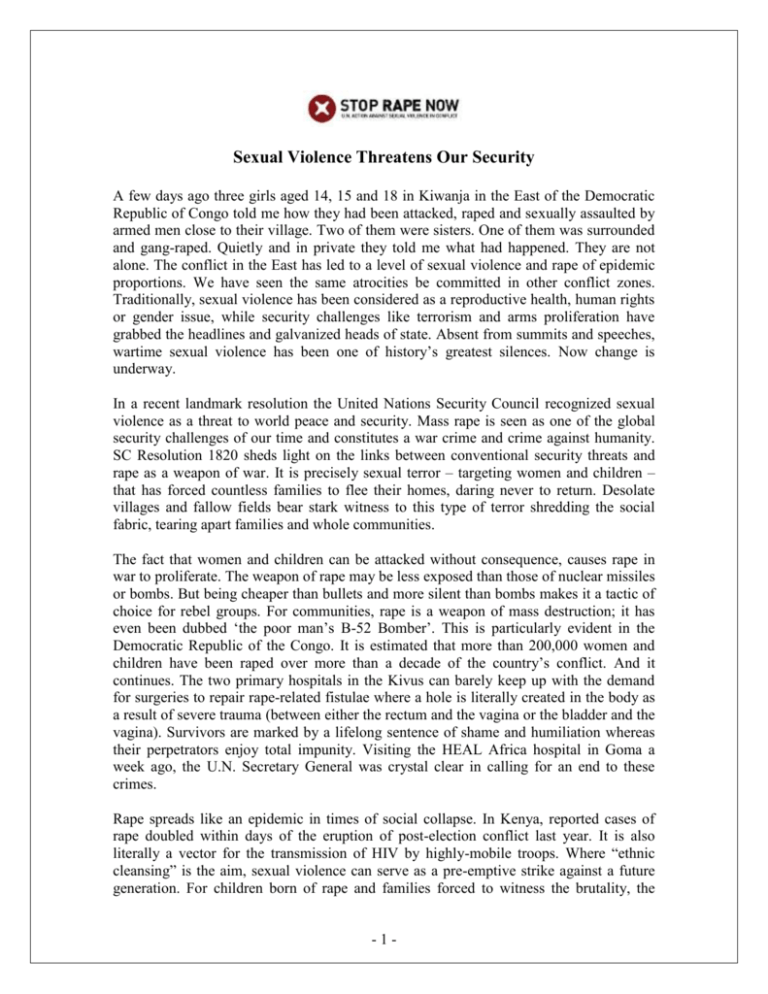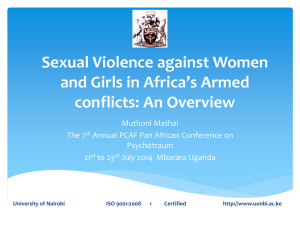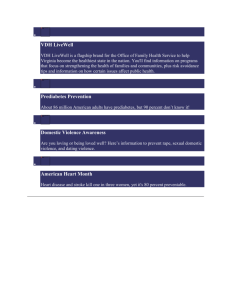
Sexual Violence Threatens Our Security
A few days ago three girls aged 14, 15 and 18 in Kiwanja in the East of the Democratic
Republic of Congo told me how they had been attacked, raped and sexually assaulted by
armed men close to their village. Two of them were sisters. One of them was surrounded
and gang-raped. Quietly and in private they told me what had happened. They are not
alone. The conflict in the East has led to a level of sexual violence and rape of epidemic
proportions. We have seen the same atrocities be committed in other conflict zones.
Traditionally, sexual violence has been considered as a reproductive health, human rights
or gender issue, while security challenges like terrorism and arms proliferation have
grabbed the headlines and galvanized heads of state. Absent from summits and speeches,
wartime sexual violence has been one of history’s greatest silences. Now change is
underway.
In a recent landmark resolution the United Nations Security Council recognized sexual
violence as a threat to world peace and security. Mass rape is seen as one of the global
security challenges of our time and constitutes a war crime and crime against humanity.
SC Resolution 1820 sheds light on the links between conventional security threats and
rape as a weapon of war. It is precisely sexual terror – targeting women and children –
that has forced countless families to flee their homes, daring never to return. Desolate
villages and fallow fields bear stark witness to this type of terror shredding the social
fabric, tearing apart families and whole communities.
The fact that women and children can be attacked without consequence, causes rape in
war to proliferate. The weapon of rape may be less exposed than those of nuclear missiles
or bombs. But being cheaper than bullets and more silent than bombs makes it a tactic of
choice for rebel groups. For communities, rape is a weapon of mass destruction; it has
even been dubbed ‘the poor man’s B-52 Bomber’. This is particularly evident in the
Democratic Republic of the Congo. It is estimated that more than 200,000 women and
children have been raped over more than a decade of the country’s conflict. And it
continues. The two primary hospitals in the Kivus can barely keep up with the demand
for surgeries to repair rape-related fistulae where a hole is literally created in the body as
a result of severe trauma (between either the rectum and the vagina or the bladder and the
vagina). Survivors are marked by a lifelong sentence of shame and humiliation whereas
their perpetrators enjoy total impunity. Visiting the HEAL Africa hospital in Goma a
week ago, the U.N. Secretary General was crystal clear in calling for an end to these
crimes.
Rape spreads like an epidemic in times of social collapse. In Kenya, reported cases of
rape doubled within days of the eruption of post-election conflict last year. It is also
literally a vector for the transmission of HIV by highly-mobile troops. Where “ethnic
cleansing” is the aim, sexual violence can serve as a pre-emptive strike against a future
generation. For children born of rape and families forced to witness the brutality, the
-1-
scars of sexual violence are as explosive as any remnant of war – perpetuating instability,
sewing the seeds of social stigmatization and triggering vicious cycles of reprisal. The
phenomenon and its effects linger long after the guns fall silent. This has been the case in
Rwanda, where the social stigmatization of children born of rapes committed during the
genocide has had long term effects on communities. In Liberia, rape remains the number
one reported crime, years after the close of civil strife.
Wartime rape has been neglected as the least condemned war crime. Mass rape by arms
bearers is directly or derivatively linked with larger military, political or economic
drivers of conflict. This is not rape out of control, but often rape under orders –
commanded or condoned in violation of the laws and customs of war. Attacking women’s
productivity has a sweeping socio-economic aftermath for nations and their neighbors:
women cannot safely collect water, food or firewood; children cannot safely get to
school. Victims have little hope of seeing their rapist brought to justice – but wellfounded fear of seeing him in fields and market-places. By holding communities hostage,
sexual violence exacerbates the feminization of poverty. No nation can achieve
development, while raping its greatest resource.
Indeed, in its effect on women and children, sexual violence can be as destructive as any
classical method of warfare and must be addressed with the same determination. If we do
not draw the line with condemnation and strong action now, tactics of sexual terror will
push the boundaries of permissible warfare. Wars are literally being fought on the bodies
of women and children. The normalization of rape and violence must end. Is it too much
to ask that on this International Women’s Day (8th March), sexual violence gets as much
attention as, say, global markets or government bailouts?
We know that tens of thousands of women have been raped in Bosnia, Sierra Leone,
DRC and Haiti. Rape victims caught up in conflict or crisis are among the world’s least
visible, least accessible people. Reliable data to inform effective interventions remains
elusive. Not only because many victims do not survive their attack and survivors are
reticent to report, but also because who or what does not count, and does not get counted.
I have personally met these victims, ranging from infants to octogenarians, in contexts
like Darfur, Liberia and DRC. Having seen the impact of this violence first-hand,
International Women’s Day seems an apt occasion to call for an end to rape as a tactic of
war. To say that sexual violence is not inevitable, is to affirm that prevention is possible.
If Security Council Resolutions are passed in poetry, but implemented in prose, then this
Resolution should be seen as a roadmap for action. It calls on parties to armed conflict to
immediately cease acts of sexual violence and protect civilians, to enforce military
discipline, uphold command responsibility, and evacuate women and children under
imminent threat to safety. The Council is otherwise empowered to impose sanctions
against perpetrators or refer the matter to an international court.
The inter-agency network, U.N. Action Against Sexual Violence in Conflict, is united in
calling for firm implementation: Security sector reforms must be gender-sensitive, vetting
armed and security forces of alleged perpetrators, ensuring no impunity when violations
-2-
are committed, making uniformed service accessible to women, and training military and
police on the prohibition of sexual violence. UN Peacekeeping Forces trained to respond
to the show or use of force must be equally prepared to combat rape and protect women
and children. For centuries, women have borne the guilt and taint of rape in the absence
of any formal attribution of liability. Highly-visible trials can place this burden squarely
where it belongs – with the perpetrator. Donor support for transitional justice and peace
processes should be conditioned on women’s inclusion, and the exclusion of sexual
violence from amnesty provisions. Moreover, a cessation of sexual violence must form
part of any ceasefire agreement, to end proxy wars waged by belligerents on one
another’s women.
It is fitting that the theme of this year’s International Women Day is “Women and Men:
United to End Violence against Women”. This is an era of the indivisibility of women’s
rights with our collective peace and security. Until the violence stops, oppression of
women will continue. Sexual violence and rape requires global action commensurate with
its global scale. After all, who is safe in a world unsafe for women?
By Hilde F. Johnson
Co-Chair of UN Action Against Sexual Violence in Conflict
5th March 2009
-3-









